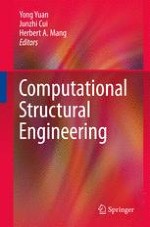2009 | OriginalPaper | Chapter
The Finite Cell Method: High Order Simulation of Complex Structures without Meshing
Authors : Ernst Rank, Alexander Düster, Dominik Schillinger, Zhengxiong Yang
Published in: Computational Structural Engineering
Publisher: Springer Netherlands
Activate our intelligent search to find suitable subject content or patents.
Select sections of text to find matching patents with Artificial Intelligence. powered by
Select sections of text to find additional relevant content using AI-assisted search. powered by
A smooth integration of geometric models and numerical simulation has been in the focus of research in computational mechanics for long, as the classical transition from CAD-based geometric models to finite element meshes is, despite all support by sophisticated preprocessors, very often still error prone and time consuming. High order finite element methods bear some advantages for a closer coupling, as much more complex surface types can be represented by p-elements than by the classical low order approach. Significant progress in the direction of model integration has recently been made with the introduction of the ‘iso-geometric analysis’ concept, where the discretization of surfaces and the Ansatz for the shape functions is based on a common concept of a NURBS-description. In this paper we discuss a recently proposed different approach, the
Finite Cell Method
, which combines ideas from fictitious domain methods with high order approximation techniques. The basic idea is an extension of a partial differential equation beyond the physical domain of computation up to the boundaries of an embedding domain, which can easier be meshed. The actual domain is only taken into account using a precise integration technique of ‘cells’ which are cut by the domains' boundary. If this extension is smooth, the solution can be well approximated by high order polynomials. The method shows exponential rate of convergence for smooth problems and good accuracy even in the presence of singularities.
